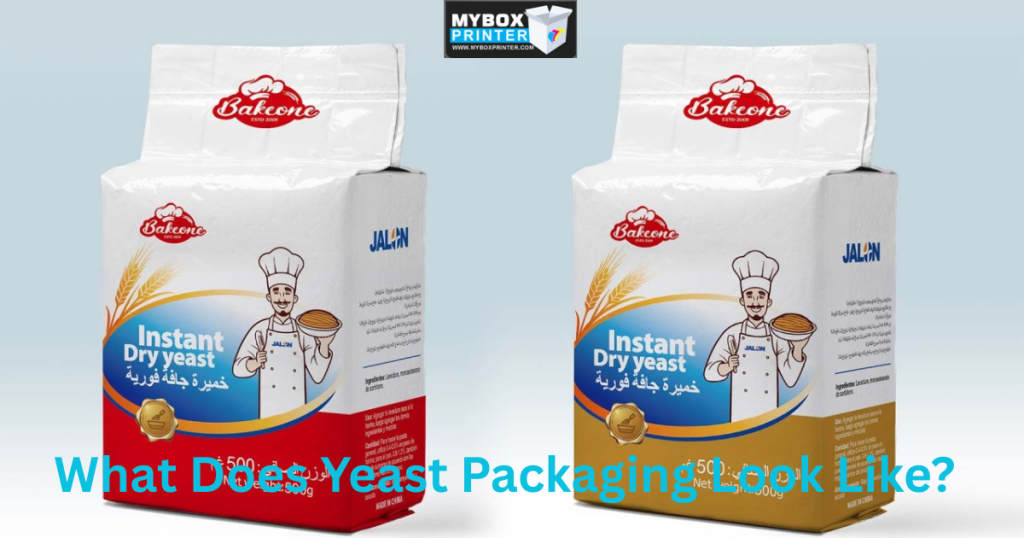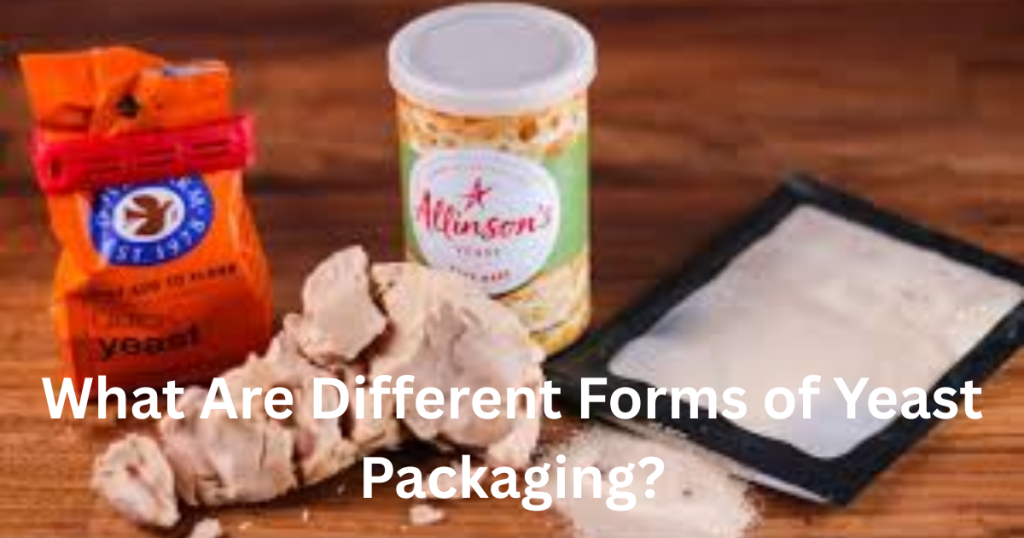
Yeast could not first catch your eye when you enter a food store. Still, it is among the most essential elements of baking and brewing. Fermentation depends on yeast whether you are cooking bread at home or making your favorite craft beer. But what does yeast packaging look like? Let’s uncover.
But have you ever stopped to think about the yeast packaging that delivers this little organism at your brewery or kitchen? If you wish to know how yeast reaches your cupboard from the manufacturing site, you are in for quite an in-depth examination of the interesting world of yeast packing.
Yeast and Its Packaging
Highly responsive to environmental factors such as moisture, temperature, and air is yeast. That is why in the final product the packaging process is so important to keep its viability and performance. Now, let us consider how yeast is shipped in packaging for experienced brewers as well as consumers who bake at home.
What Are Different Forms of Yeast Packaging?

Little is more fragile than yeast’s life cycle; therefore, its packaging should keep it viable until you are about to use it. Custom yeast packaging makes yeast simple to use, preserves its shelf life, and helps to shield it from environmental conditions (such as moisture and heat). Based on the kind of yeast and its desired application, yeast packaging comes in several shapes.
1. Active Dry Yeast Packaging
One of the most prevalent kinds of yeast for amateur bakers is active dry yeast. Depending on your requirements, it is sold in little packets or big jars. Active dry packaging for yeast usually clearly tells how to activate the yeast (normally by warm water dissolution) to guarantee its top performance upon addition to dough or batter.
Active dry yeast packing often consists of:
- Foil or Plastic Sachets
There are small foil packets are the typical form of packaging for live dry yeast. Tightly sealed to keep the yeast from dying by not getting moisture and air. Enough for one loaf of bread, one packet usually has around 7 grams (or 2.25 tablespoons) of yeast.
- Large Foil Bags
Vacuum-sealed pouches might also be used for bulk packaging of yeast for industrial bakers or large consumers. They are also popular among food producers and bakeries and usually have a kilogram or more of yeast. Usually, they will be resealable to maintain freshness from the open.
2. Instant Yeast Packing
Fast-reacting than active dry yeast- instant yeast has a little different packaging since it does not need to be activated in water before being combined with flour. Instant yeast packing most notably contains the following traits:
- Small Packets
Just like active dry yeast, instant yeast is frequently packaged in little, personal sachets or in larger commercial-use vacuum-sealed bags. Unlike active yeast, instant yeast can be combined right with dry ingredients without first being dissolved.
- Resealable Pouches
Resealable, moisture-proof bags are sometimes used to keep quick yeast fresh after opened when it is packaged in bulk. Usually stored in airtight boxes or vacuum-sealed pouches, quick yeast prevents oxygen exposure to degrade it.
3. Fresh Yeast Packaging
Perishable product fresh yeast- also known as cake yeast- should be refrigerated. Generally available in compact blocks, this kind of yeast would be packaged to show its fragility definitively. Packaging for fresh yeast usually has clear labels saying customers should keep it in the refrigerator and use it soon.
- Foil or Wax Paper Wrap
Fresh yeast is commonly packaged in small blocks covered in foil or wax paper to keep it off air and light. These blocks are afterward put in a vacuum-sealed bag or plastic box to add extra safety.
- Increase Shelf Life
Fresh yeast usually only lasts a few weeks, different from dry yeasts. Therefore, it is vital the packing holds the yeast as fresh as can be; some companies include inert gases inside the packaging to lengthen the usefulness of the product. Packaging for fresh yeast usually has clear labels saying customers should keep it in the refrigerator and use it soon.
4. Liquid Yeast (Active Yeast for Brewing)
Fermentation in the brewing field often uses liquid yeast. The living yeast cultures are to be maintained in liquid yeast packages while also providing simple usability for brewers.
Glass Vials or Bottles
Liquid yeast typically comes in glass bottles or glass vials. These solid glass jars are sealed to avoid contamination of the yeast before sterilization. Often labeled with an exact strain of yeast, which is key for the kind of beer being produced, the vials.

- Vacuum Seals and Gassing
Many liquid yeast packets are vacuum sealed or gassed with inert gases such as nitrogen to slow oxidation and lengthen shelf life in order to protect the yeast’s health.
- Cold Chain Packaging
Cold Chain Packaging: Many businesses use cold chain logistics, whereby the yeast is stored at a constant low temperature during shipping and storage since liquid yeast is perishable. To guarantee the yeast remains intact during shipping, packaging offers thermal insulation and ice packs.
Why Is Yeast Packaging Crucial?

After learning what does yeast packaging look like, you may be interested to know the significance of yeast packing. Hence, in this section, you will learn how the yeast’s packaging is critical for guaranteeing it reaches the user in a usable condition rather than just a marketing ploy. Packaging is particularly important for yeast for a few main reasons:
- Protection from Moisture and Air
Oxygen and humidity must be prevented to keep the yeast fresh and usable. So it is necessary to package the yeast in dry air to prevent spoilage or preactivation. This is especially true of dry yeast; the cells of the yeast may perish if they are in contact with air or moisture.
- Keeping the Yeast Fresh
By shielding it from environmental stresses, packaging lengthens the shelf life of yeast. Foil, plastic, or vacuum sealing is almost all yeast packets used to keep it fresh and strong until it is ready for use. Without this, the yeast would be useless for baking or brewing since it might lose its fermenting powers.
- Display Recipe on Yeast Boxes
Yeast is packaged with the consumer in mind. Home bakers will find small packets perfect since they give an exact quantity for a single recipe. By contrast, commercial yeast packaging is bigger and usually carries reseal bags, hence allowing companies to use the yeast in quantity without loss of freshness.
- Refrigeration Needs
Good packaging and cold storage are absolutely necessary for fresh yeast and liquid yeast. Highly volatile fresh yeast will spoil fast if not kept cold and in airtight packaging. To maintain the yeast’s necessary cold storage needs, packaging materials like vacuum-sealed bags help protect the yeast from the environment.
Changing Trends In Yeast Packaging
As with many other food products, yeast packing is changing to address consumer requirements for sustainability and efficiency. Recent developments in yeast packing consist in:
- More Usage of Eco-friendly Materials
With a rising focus on sustainability, several companies are using biodegradable or recyclable materials for yeast packing. Growing in popularity, paper and plant-based plastics lower the environmental cost of packaging.
- Small and Portable Packaging
Home bakers are increasingly gravitating to smaller, single-use yeast boxes that cut waste and simplify storage.
- Smart Packaging
In more sophisticated packaging of the future, built-in freshness readouts will let consumers know if yeast is still viable.
Conclusion
This would appear to be a tiny little aspect of the entire cooking and brewing process, yet yeast packaging becomes vital when it comes to keeping the potency of the product. The packaging is designed to keep your yeast fresh, powerful, and ready to perform its fermenting-wonder magic, whether it be fresh, instant, or active dry yeast.
Understanding the packaging helps you make better choices regarding storage for optimum performance and what yeast to buy. Also, it is important to make a fine purchase of the custom printed yeast packaging. MyBoxPrinter is the best site to order customized yeast packaging boxes.
So next time you pick up a packet of yeast, take a moment to appreciate the science behind its packaging. It isn’t only about ease; it’s about guaranteeing the yeast inside is prepared to produce your next loaf of bread to rise or your beer batch to ferment perfectly.
Frequently Asked Questions
How much yeast is in one package?
One package contains about 7 grams of yeast. This amount is equal to 2 ½ tablespoons of the yeats.
How to store package yeast?
The storage of yeast can be prolonged by keeping it in a cool, dry,, and airtight packet.
How long will packaged yeast last?
The package of yeast lasts for up to 2 years. But once the packet is opened, dry yeast will last for about 6 months in the right conditions. Fresh yeast has only a lifetime of 2-3 weeks.
What temperature kills yeast?
Yeast starts dying at 140°F (60°C).


